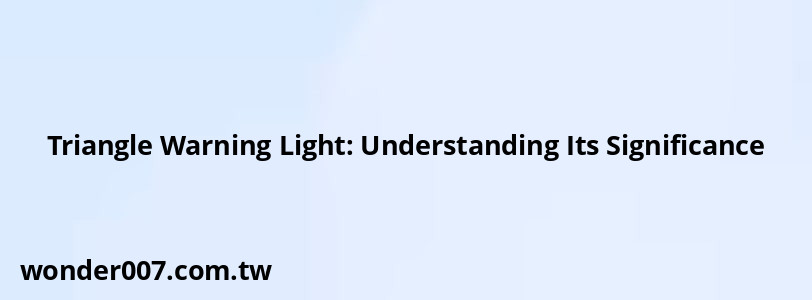Triangle Warning Light: Understanding Its Significance

The triangle warning light, often seen on vehicle dashboards, is a crucial alert symbol that indicates a general issue within the vehicle's systems. This icon typically features a triangle shape with an exclamation mark in the center and serves as a catch-all warning light. It does not specify the exact problem but signals that something requires your attention.
What Does the Triangle Warning Light Mean?
The triangle warning light can illuminate for various reasons, ranging from minor to serious issues. Here are some common causes:
- General System Alert: This light may appear when there is a malfunction in one of the vehicle's systems that does not have a dedicated warning light.
- Brake System Issues: Problems such as low brake fluid or worn brake pads can trigger this warning.
- Traction Control Malfunctions: If there is an issue with the traction control system, this light may illuminate, indicating potential wheel spin or loss of traction.
- Engine Problems: The light may also indicate engine malfunctions, such as overheating or low oil pressure.
- Maintenance Reminders: In some vehicles, it can serve as a reminder for routine maintenance tasks like oil changes or tire rotations.
Importance of Addressing the Warning Light
When the triangle warning light activates, it is essential to not ignore it. Here’s why:
- Safety Risks: Ignoring this warning could lead to serious safety issues while driving. For instance, brake system failures can significantly impact stopping power.
- Potential Damage: Continuing to drive without addressing the underlying issue may cause further damage to your vehicle, leading to more costly repairs.
- Immediate Attention Needed: Depending on the context of the warning (e.g., if accompanied by strange noises or performance issues), it may be necessary to pull over safely and seek assistance.
Responding to the Triangle Warning Light
Upon seeing this warning light, follow these steps:
1. Check the Dashboard Messages: Many vehicles provide additional information through their onboard display systems. Look for specific messages that accompany the triangle warning light.
2. Assess for Other Symptoms: If there are no additional messages but you notice unusual behavior (like steam from the engine), it’s best to stop driving and call for help.
3. Consult a Professional: If you're unsure about the cause or if the light remains illuminated after addressing potential minor issues, take your vehicle to a qualified mechanic for a thorough inspection.
FAQs About Triangle Warning Light
- What should I do if my triangle warning light comes on?
Check your dashboard for additional messages and assess any symptoms. If unsure, consult a mechanic. - Can I continue driving with this warning light on?
It depends on the issue; minor problems may allow continued driving, but serious issues require immediate attention. - How can I reset the triangle warning light?
The process varies by vehicle; refer to your owner's manual or consult a professional.
Understanding the significance of the triangle warning light and responding appropriately is vital for maintaining vehicle safety and performance. Always prioritize addressing any alerts promptly to ensure both your safety and that of others on the road.
Related Posts
-
Car Warning Light Exclamation Mark: What It Means and What to Do
26-01-2025 • 255 views -
Hino Dash Warning Lights: What They Mean and How to Respond
26-01-2025 • 349 views -
35 Over 20 Tint: Understanding Window Darkness
30-01-2025 • 134 views -
Oil Pressure Warning Light: What It Means and What to Do
29-01-2025 • 138 views -
BMW Brake Pad Warning Light: Reset Guide
29-01-2025 • 177 views
Latest Posts
-
Are O2 Sensors Covered Under Warranty
01-02-2025 • 338 views -
Power Steering Fluid Leak On Passenger Side
01-02-2025 • 419 views -
How To Turn Off Paddle Shifters Mercedes
01-02-2025 • 333 views -
2015 Chevy Traverse AC Recharge Port Location
01-02-2025 • 365 views -
Rear Brake Caliper Piston Won't Compress
01-02-2025 • 312 views
Popular Posts
-
V12 Engine Costs: What You Need to Know
26-01-2025 • 630 views -
Hino Warning Lights: Understanding Dashboard Alerts
26-01-2025 • 634 views -
EPC Warning Light: What It Means for Your Vehicle
27-01-2025 • 591 views -
Power Steering and ABS Light On: Causes and Solutions
27-01-2025 • 612 views -
EPC Light: Understanding Causes and Solutions
26-01-2025 • 1019 views
